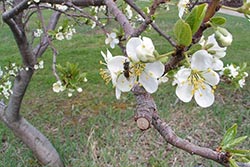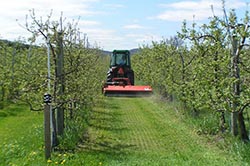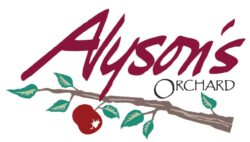 Alyson’s apples have been certified as Eco-Apples. As an Eco-Apple farmer, we ensure specific growing practices. This program was developed by Red Tomato, a non-profit organization whose mission is “to connect farmers and consumers through marketing, trade and education, and through a passionate belief that a family-farm, locally-based, ecological, fair trade food system is the way to a better tomato” (or better apple).
Alyson’s apples have been certified as Eco-Apples. As an Eco-Apple farmer, we ensure specific growing practices. This program was developed by Red Tomato, a non-profit organization whose mission is “to connect farmers and consumers through marketing, trade and education, and through a passionate belief that a family-farm, locally-based, ecological, fair trade food system is the way to a better tomato” (or better apple).
We use a combination of long-standing agricultural techniques as well as advanced ecological orchard management methods to minimize spraying and other environmentally disruptive practices. This practice, known as integrated pest management (IPM), can prevent pest infestations and organic problems before they happen by monitoring crops and treating only as needed. We also help prevent problems in the orchard through land management such as careful mowing and monitoring of growing conditions.
IPM is beneficial to the consumer because it often means fewer chemicals have been applied to the crops, and is beneficial to the farmer (and consequently the consumer) because it can lower the costs of growing. It improves the health of the soil and lowers fuel consumption.
Consumers and neighbors who are concerned about human health and the environment should be aware that orchards like Alyson’s are leading the way to a safe and vibrant agro-ecosystem!
Link to: http://www.redtomato.org/ecoapple.php
Link to: http://epa.gov/pesticides/factsheets/ipm.htm
Winter Means Pruning and Planning
 The growing year begins in the coldest months when the trees are thoughtfully pruned. This handiwork is essential, for judicious pruning reduces conditions favorable to disease and allows more sunlight into the tree to ripen the fruit evenly. After the pruning is complete the brush is pulled into the rows and then pushed into large piles to be burned in preparation for the upcoming mowing season. Late winter is also the best time of year to graft the trees.
The growing year begins in the coldest months when the trees are thoughtfully pruned. This handiwork is essential, for judicious pruning reduces conditions favorable to disease and allows more sunlight into the tree to ripen the fruit evenly. After the pruning is complete the brush is pulled into the rows and then pushed into large piles to be burned in preparation for the upcoming mowing season. Late winter is also the best time of year to graft the trees.
Spring Means Planting and Pollinating
 By mid-May, the orchard is a blanket of white and pink blossoms. The fragrance of apple, plum and peach nectar entices millions of wild bees to the orchard. Effective pollination is absolutely essential. So, just as the first blossoms begin to open we bring in about 45 hives to assist the native population of wild bees. The fate of the entire crop depends on a brief period of warm sun, windless days, and the diligence of the bees.
By mid-May, the orchard is a blanket of white and pink blossoms. The fragrance of apple, plum and peach nectar entices millions of wild bees to the orchard. Effective pollination is absolutely essential. So, just as the first blossoms begin to open we bring in about 45 hives to assist the native population of wild bees. The fate of the entire crop depends on a brief period of warm sun, windless days, and the diligence of the bees.
Summer Means Growing and Nurturing
 During the summer months, mowing is done in the drive rows, sprays are applied as needed and many other projects are completed in preparation for harvest. Over the course of the growing season we use many techniques to maintain and nurture our orchard. Hand thinning of peaches is an important process here at Alyson’s. This can be a time consuming task but it plays a vital role in ensuring the growth of large, quality fruit for our customers to enjoy.
During the summer months, mowing is done in the drive rows, sprays are applied as needed and many other projects are completed in preparation for harvest. Over the course of the growing season we use many techniques to maintain and nurture our orchard. Hand thinning of peaches is an important process here at Alyson’s. This can be a time consuming task but it plays a vital role in ensuring the growth of large, quality fruit for our customers to enjoy.
Fall Means Harvesting and Storing
 By summer’s end, if nature has been good to us, there is a bountiful crop to harvest. Early September sees a dramatic change in the orchard. Each of more than fifty varieties of apples has been developing its characteristic snap, taste and color. Each variety of fruit is harvested at its peak of flavor. Harvesting goes on without a break until the end of October when the last apples are picked. Later-maturing varieties such as the Russets and Fujis are our “winter keepers.”
By summer’s end, if nature has been good to us, there is a bountiful crop to harvest. Early September sees a dramatic change in the orchard. Each of more than fifty varieties of apples has been developing its characteristic snap, taste and color. Each variety of fruit is harvested at its peak of flavor. Harvesting goes on without a break until the end of October when the last apples are picked. Later-maturing varieties such as the Russets and Fujis are our “winter keepers.”
